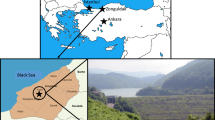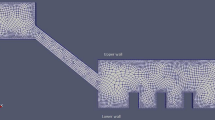Abstract
Lahars are water-sediment mass flows from a volcanic source. They can be triggered by a variety of mechanisms and span a continuum of flow rheology and hydraulic properties, even within the same event. Lahars are extremely powerful landscaping agents and represent a considerable hazard potential. However, this highly dynamic character and a lack of direct measurements has made modelling lahars difficult. This study therefore applies a fluid dynamics model; Delft3D, to analyse the 18th March 2007 dam break lahar at Mount Ruapehu, New Zealand. The modelled lahar routed through the Whangaehu gorge in ~30 min, crossed the Whangaehu fan in ~60 min, and then over a further 3 h travelled an additional ~22 km distance along the Whangaehu River to the Tangiwai bridge. The modelled mean frontal velocity was 6.5 m s−1 along the gorge although peak velocity reached up to 19.6 m s−1. The modelled lahar flow front progressively slowed across the fan but along the River it accelerated from 2.1–3.3 m s−1. Calculated peak velocity along the River was <4.5 m s−1. These results generally compare well with gauged records, with historical records, and with other modelling approaches. However, discrepancies in frontal velocity and time to peak stage arise due to (1) specifying roughness, which arises from slope variations between adjacent computational nodes, and which is stage-dependant, and (2) due to rapid topographic changes that produce frequent hydraulic jumps, which are inadequately accommodated in the numerical scheme. The overall pattern of discharge attenuation, and of relationships between topographic and hydraulic variables, is similar to that calculated for lahars on other volcanoes. This modelling method could be applied at other similar sites where a likely source hydrograph and high-resolution topographic data are available. These results have important implications for hazard management at Ruapehu and for examining geomorphic and sedimentary impacts of this lahar.












Similar content being viewed by others
References
Apmann RP (1973) Estimating discharge from superelevation in bends. J Hydraul Div Am Soc Civil Eng 99:65–79
Armanini A, Capart H, Fraccarollo L, Larcher M (2005) Rheological stratification in experimental free-surface flows of granular-liquid mixtures. J Fluid Mech 532:269–319
Berti M, Simoni A (2007) Prediction of debris flow inundation areas using empirical mobility relationships. Geomorphol 90:144–161
Bulmer MH, Barnouin-Jha OS, Peitersen MN, Bourke M (2002) An empirical approach to studying debris flows: implications for planetary modeling studies. J Geophys Res 100:24509–24519
Carrivick JL (2006) 2D modelling of high-magnitude outburst floods; an example from Kverkfjöll, Iceland. J Hydrol 321:187–199
Carrivick JL (2007a) Modelling coupled hydraulics and sediment transport, and geomorphology of a high-magnitude outburst flood. Ann Glaciol 44:143–154
Carrivick JL (2007b) Hydrodynamics and geomorphic work of jökulhlaups (glacial outburst floods) from Kverkfjöll volcano, Iceland. Hydrol Process 21:725–740
Caruso P, Pareschi MT (1993) Behaviour and numerical simulation of channelled lahars and lahar-run out flows. Environ Geol Water Sci 22:141–152
Chen H, Lee CF (2000) Numerical simulation of debris flows. Can Geotechn J 37:146–160
Chester DK, Degg M, Duncan AM, Guest JE (2001) The increasing exposure of cities to the effects of volcanic eruptions: a global survey. Environ Hazards 2:89–103
Christenson BW, Wood CP (1993) Evolution of a vent-hosted hydrothermal system beneath Ruapehu Crater Lake, New Zealand. Bull Volcanol 55:547–565
Connell RJ, Beffa C, Painter DJ (1998) Comparison of observations by flood plain residents with results from a two-dimensional flood plain model: Waihao River, New Zealand. J Hydrol (NZ) 37:55–79
Costa JE (1997) Hydraulic modelling for lahar hazards at Cascades volcanoes. Environ Eng Geosci 3:21–30
Cronin SJ, Neall VE (1997) A late quaternary stratigraphic framework for the northeastern Ruapehu and eastern Tongariro ring plains, New Zealand. NZ J Geol Geophys 40:185–197
Cronin SJ, Neall VE, Palmer AS (1996a) Geological history of the north–eastern ring plain of Ruapehu volcano, New Zealand. Q Int 34:21–28
Cronin SJ, Neall VE, Lecointre JA, Palmer AS (1996b) Unusual “snow slurry” lahars from Ruapehu volcano, New Zealand, September 1995. Geology 24:1107–1110
Cronin SJ, Hodgson KA, Neall VE, Palmer AS, Lecointre JA (1997a) 1995 Ruapehu lahars in relation to the late Holocene lahars of Whangaehu River, New Zealand. NZ J Geol Geophys 40:507–552
Cronin SJ, Neall VE, Lecointre JA, Palmer AS (1997b) Changes in Whangaehu river lahar characteristics during the 1995 eruption sequence, Ruapehu volcano, New Zealand. J Volcanol Geotherm Res 76:47–61
Cronin SJ, Neall VE, Lecointre JA, Palmer AS (1999) Dynamic interactions between lahars and stream flow: a case study from Ruapehu volcano, New Zealand. Geol Soc Am Bull 111:28–38
Delft Hydraulics (2007) Download Delft3D user manuals. http://delftsoftware.wldelft.nl/index.php?option=com_docman&task=cat_view&gid=39&Itemid=82. Accessed 20 May 2007
Fagents SA, Baloga SM (2005) Calculation of lahar transit times using digital elevation data. J Volcanol Geotherm Res 139:135–146
Fagents SA, Baloga SM (2006) Toward a model for the bulking and debulking of lahars. J Geophys Res 111:B10201
Fairchild LH (1987) The importance of lahar initiation processes. Geol Soc Am Rev Eng Geol 7:51–61
French JR (2003) Airborne LiDAR in support of geomorphological and hydraulic modelling. Earth Surf Process Landforms 28:321–335
Glaze LS, Baloga SM, Barnouin-Jha OS (2002) Rheologic inferences from high water marks of debris flows. Geophys Res Lett 29:49-1–49-4
Hancox GT, Keys H, Webby MG (2001) Assessment and mitigation of dam-break lahar hazards from Mt Ruapehu Crater Lake following the 1995–96 eruptions. In: McManus KJ (ed) Engineering and development in hazardous terrains. New Zealand Geotechnical Society, NZ Institute of Professional Engineers, Christchurch, pp 385–409
Hodgson KA, Manville VR (1999) Sedimentology and flow behavior of a rain-triggered lahar, Mangatoetoenui Stream, Ruapehu volcano, New Zealand. Geol Soc Am Bull 111:743–754
Hubbard BE, Sheridan MF, Carrasco-Núñez G, Díaz-Castellón R, Rodríguez SR (2007) Comparative lahar hazard mapping at Volcan Citlaltépetl, Mexico using SRTM, ASTER and DTED-1 digital topographic data. J Volcanol Geotherm Res 160:99–124
Iverson RM (1997) The physics of debris flows. Rev Geophys 35:245–296
Iverson RM, Denlinger RP (2001) Flow of variably fluidized granular masses across three-dimensional terrain: 1. Coulomb mixture theory. J Geophys Res 106:537–552
Iverson RM, Vallance JW (2001) New views of granular mass flows. Geology 29:115–118
Iverson RM, Schilling SP, Vallance JW (1998) Objective delineation of lahar-inundation hazard zones. Geol Soc Am Bull 110:972–984
Johnston DM, Houghton BF, Neall VE, Ronan KR, Paton D (2000) Impacts of the 1945 and 1995–1996 Ruapehu eruptions, New Zealand; an example of increasing societal vulnerability. Geol Soc Am Bull 112:720–726
Laenen A, Hansen RP (1988) Simulation of three lahars in the Mount St. Helens area, Washington using a one-dimensional, unsteady-state streamflow model: water-resources investigation report. United States Geological Survey, Reston, p 20
Lecointre JA, Neall VE, Palmer AS (1998) Quaternary lahar stratigraphy of the western Ruapehu ring plain, New Zealand. N Z J Geol Geophys 41:225–246
Macedonio G, Pareschi MT (1992) Numerical simulation of some lahars from Mt St Helens. J Volcanol Geotherm Res 54:65–80
Macías JL, Capra L, Scott KM, Espíndola JM, García-Palomo A, Costa JE (2004) The 26 May 1982 breakout flows derived from failure of a volcanic dam at El Chichón, Chiapas, Mexico. Geol Soc Amer Bull 116:233–246
Major JJ, Pierson TC (1992) Debris flow rheology: experimental analysis of fine-grained slurries. Water Resour Res 28:841–857
Manville V (2001) Techniques for evaluating the size of potential dam-break floods from natural dams. Science report. Institute of Geological and Nuclear Sciences, Wellington, p 70
Manville V (2004) Palaeohydraulic analysis of the 1953 Tangiwai lahar New Zealand’s worst volcanic disaster. Acta Vulcanol XVI:137–152
Manville M, White JDL (2003) Incipient granular mass flows at the base of sediment-laden floods, and the roles of flow competence and flow capacity in the deposition of stratified bouldery sands. Sediment Geol 155:157–173
Manville V, White JDL, Hodgson KA (2000) Dynamic interactions between lahars and stream flow: a case study from Ruapehu volcano, New Zealand: discussion and reply. Geol Soc Amer Bull 112:1149–1151
Muñoz-Salinas E, Manea VC, Palacios D, Castillo-Rodriguez M (2007) Estimation of lahar flow velocity on Popocatépetl volcano (Mexico). Geomorphology 92:91–99
NASA/GSFC/METI/ERSDAC/JAROS and U.S./Japan ASTER Science Team (2007) Mt Ruapehu, New Zealand. http://asterweb.jpl.nasa.gov/gallery-detail.asp?name=ruapehu NASA. Accessed 8 Aug 2007
Nicholas AP, Mitchell CA (2003) Numerical simulation of overbank processes in topographically complex floodplain environments. Hydrol Process 17:727–746
O’Shea BE (1954) Ruapehu and the Tangiwai disaster. N Z J Sci Technol B36:174–189
Pierson TC (1985) Initiation and flow behavior of the 1980 Pine Creek and Muddy River lahars, Mount St. Helens, Washington. Geol Soc Amer Bull 96:1056–1069
Pierson TC (1998) An empirical method for estimating travel times for wet volcanic mass flows. Bull Volcanol 60:98–109
Pierson TC, Janda RL, Thouret JC, Borrero CA (1990) Perturbation and melting of snow and ice by the 13 November 1985 eruption of Nevado del Ruiz, Colombia and consequent mobilization, flow and deposition of lahars. J Volcanol Geotherm Res 41:17–66
Ponce VM (1994) Engineering hydrology. Principles and practices. Prentice-Hall, Upper Saddle River, p 320
Rushmer EL (2007) Physical-scale modelling of jökulhlaups (glacial outburst floods) with contrasting hydrograph shapes. Earth Surf Processes Landf 32:954–963
Scott KM, Vallance JW, Pringle PT (1995) Sedimentology, behavior, and hazards of debris flows at Mount Rainier, Washington. U.S. Geol Surv Prof Pap 1547:56
Sheridan MF, Stinton AJ, Patra A, Pitman EB, Bauer A, Nichita CC (2005) Evaluating Titan2D mass-flow model using the 1963 Little Tahoma Peak avalanches, Mount Rainier, Washington. J Volcanol Geotherm Res 139:89–102
Simkin T, Siebert L, Blong R (2001) Volcano fatalities—lessons from the historical record. Science 291:255
Sosio R, Crosta GB, Frattini P (2007) Field observations, rheological testing and numerical modelling of a debris-flow event. Earth Surf Processes Landf 32:290–306
Stelling GS (1984) On the construction of computational methods for shallow water flow problems. Rijkswaterstaat Communications 35. Rijkswaterstaat, The Hague
Stevens NF, Manville V, Heron DW (2003) The sensitivity of a volcanic flow model to digital elevation model accuracy: experiments with digitised map contours and interferometric SAR at Ruapehu and Taranaki volcanoes, New Zealand. J Volcanol Geotherm Res 119:89–105
Takahashi T, Nakagawa H, Harada T, Yamashiki Y (1992) Routing debris flows with particle segregation. J Hydraul Eng 118:1490–1507
Toyos G, Oramas Dorta D, Oppenheimer C, Pareschi MT, Sulpizio R, Zanchetta G (2007) GIS-assisted modelling for debris flow hazard assessment based on the events of May 1998 in the area of Sarno, Southern Italy: Part I. Maximum run-out. Earth Surf Processes Landf 32:1491–1502
Vignaux M, Weir GJ (1989) A general model for Mt. Ruapehu lahars. Bull Volcanol 52:381–390
Weare TJ (1979) Errors arising from irregular boundaries in ADI solutions of the shallow water equations. Int J Numer Methods Eng 14:921–931
Weir GJ (1982) Kinematic wave theory for Ruapehu lahars. N Z J Sci 25:197–203
Witham CS (2005) Volcanic disasters and incidents: a new database. J Volcanol Geotherm Res 148:191–233
Acknowledgements
Delft Hydraulics provided greatly discounted software support and maintenance. Data was provided by J. Watson and J. Halstead, (Horizons Regional Council) for the OnTrack and Wahianoa Aqueduct gauge data, B. Waugh (National Institute of Water and Atmospheric Research) for the Karioi gauge data, and H. Keys and C. Lawrence (Department of Conservation) for Crater Lake data. Carrivick received a Royal Society Research Grant for this project. Cronin and Manville are funded by a Royal Society of New Zealand Marsden grant (MAU0512), New Zealand Foundation for Research Science and Technology grants to GNS Science (CO5X0006) and Massey University (MAUX0401), a Massey University research grant, and the New Zealand Earthquake Commission (EQC06/518). LiDAR data was captured by Fugro Spatial Solutions Pty Ltd. (Australia) and New Zealand Aerial Mapping. Hilary McMillan and Suzy Cole provided 18th March 2007 flow records and reconstructions. Comments from Sarah Fagents, two anonymous reviewers and Jeremy Phillips as Editor improved the coherence of this paper and broadened its applicability to a wider audience.
Author information
Authors and Affiliations
Corresponding author
Additional information
Editorial responsibility: JC Phillips
Rights and permissions
About this article
Cite this article
Carrivick, J.L., Manville, V. & Cronin, S.J. A fluid dynamics approach to modelling the 18th March 2007 lahar at Mt. Ruapehu, New Zealand. Bull Volcanol 71, 153–169 (2009). https://doi.org/10.1007/s00445-008-0213-2
Received:
Accepted:
Published:
Issue Date:
DOI: https://doi.org/10.1007/s00445-008-0213-2




